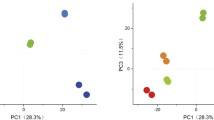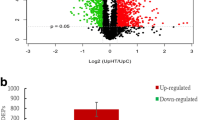Abstract
We aimed to gain a better understanding of cold adaption in Mortierella isabellina M6-22 by using proteomics approaches. The temperature range and optimal temperature for M6-22 growth were investigated, and composition changes in fatty acids were analyzed. Accompanied with the 2-D gel electrophoresis, MALDI-TOF/TOF–MS analysis was conducted to characterize alterations in protein profiling in M6-22 cultured at 30 °C for 24 h and 15 °C for another 24 h when compared with those cultured at 30 °C for 48 h. Gene Ontology (GO) cluster analysis was finally conducted for successfully identified proteins. M6-22 cells could grow well at temperatures ranging from 15 to 30 °C. As temperature decreased from 30 to 15 °C, LA and GLA significantly increased from 11.63 to 17.85 % and from 9.12 to 13.19 %, respectively, while oleic acid significantly decreased from 47.25 to 36.53 %. Proteomics analyses revealed 111 differentially expressed protein spots, among which 5 unique proteins (A38, A40, A47, A49 and A58), 29 up-regulated proteins and 10 down-regulated proteins were identified by MALDI-TOF/TOF–MS. GO enrichment analysis demonstrated that these proteins mainly involved in glycolytic pathway (A34 and A50), electron transport (A28), ATP production (A35 and B39) and protein modification (A38). A total of 44 differentially expressed proteins have been successfully identified in M. isabellina M6-22 cultured at 15 °C. These proteins may play important roles in cold adaption via regulation of ATP synthesis, activation of cold-adaptive proteins, degradation of needless protein, accumulation of PUFAs, etc.



Similar content being viewed by others
References
Aki T et al (2001) Production of arachidonic acid by filamentous fungus, Mortierella alliacea strain YN-15. J Am Oil Chem Soc 78:599–604
Bakermans C, Tollaksen SL, Giometti CS, Wilkerson C, Tiedje JM, Thomashow MF (2007) Proteomic analysis of Psychrobacter cryohalolentis K5 during growth at subzero temperatures. Extremophiles 11:343–354
Beere HM, Green DR (2001) Stress management–heat shock protein-70 and the regulation of apoptosis. Trends Cell Biol 11:6–10
Calder PC (2008) Polyunsaturated fatty acids, inflammatory processes and inflammatory bowel diseases. Mol Nutr Food Res 52:885–897
Chatzifragkou A, Fakas S, Galiotou-Panayotou M, Komaitis M, Aggelis G, Papanikolaou S (2010) Commercial sugars as substrates for lipid accumulation in Cunninghamella echinulata and Mortierella isabellina fungi. Eur J Lipid Sci Technol 112:1048–1057
Chen Z, Pervaiz S (2010) Involvement of cytochrome c oxidase subunits Va and Vb in the regulation of cancer cell metabolism by Bcl-2. Cell Death Differ 17:408–420
Cui S, Huang F, Wang J, Ma X, Cheng Y, Liu J (2005) A proteomic analysis of cold stress responses in rice seedlings. Proteomics 5:3162–3172
Economou CN, Aggelis G, Pavlou S, Vayenas D (2011) Single cell oil production from rice hulls hydrolysate. Bioresour Technol 102:9737–9742
Garnier M, Matamoros S, Chevret D, Pilet M-F, Leroi F, Tresse O (2010) Adaptation to cold and proteomic responses of the psychrotrophic biopreservative Lactococcus piscium strain CNCM I-4031. Appl Environ Microbiol 76:8011–8018
Gentile G, Bonasera V, Amico C, Giuliano L, Yakimov M (2003) Shewanella sp. GA-22, a psychrophilic hydrocarbonoclastic antarctic bacterium producing polyunsaturated fatty acids. J Appl Microbiol 95:1124–1133
He J et al (2015) Correlation of polyunsaturated fatty acids with the cold adaptation of Rhodotorula glutinis. Yeast 32:683–690
Imai Y, Soda M, Takahashi R (2000) Parkin suppresses unfolded protein stress-induced cell death through its E3 ubiquitin-protein ligase activity. J Biol Chem 275:35661–35664
Isaacson T et al (2006) Sample extraction techniques for enhanced proteomic analysis of plant tissues. Nat Protoc 1:769–774
Kang Y, Xian M, Wang J, Cheng T, Li W, Bi W (2002) Effects of mycelial biomembrane fluidity on the activity of desaturases. J Mol Catal 16:1–4
Kosová K, Vítámvás P, Sb Planchon, Renaut J, Vanková R, Prášil IT (2013) Proteome analysis of cold response in spring and winter wheat (Triticum aestivum) crowns reveals similarities in stress adaptation and differences in regulatory processes between the growth habits. J Proteome Res 12:4830–4845
Kostadinova N, Vassilev S, Spasova B, Angelova M (2011) Cold stress in antarctic fungi targets enzymes of the glycolytic pathway and tricarboxylic acid cycle. Biotechnol Biotechnol Equip 25:50–57
Kregel KC (2002) Invited review: heat shock proteins: modifying factors in physiological stress responses and acquired thermotolerance. J Appl Physiol 92:2177–2186
Lee GJ, Vierling E (2000) A small heat shock protein cooperates with heat shock protein 70 systems to reactivate a heat-denatured protein. Plant Physiol 122:189–198
Lu H, Zhang X, Li J, T-g LEI (2005) Effects of adversity on fatty acid composition in fungal membrane. J Microbiol 25:1–3
Mamatha S, Ravi R, Venkateswaran G (2008) Medium optimization of gamma linolenic acid production in Mucor rouxii CFR-G15 using RSM. Food Bioprocess Technol 1:405–409
Nichols DS, Miller MR, Davies NW, Goodchild A, Raftery M, Cavicchioli R (2004) Cold adaptation in the Antarctic archaeon Methanococcoides burtonii involves membrane lipid unsaturation. J Bacteriol 186:8508–8515
O’Meara TR, Hay C, Price MS, Giles S, Alspaugh JA (2010) Cryptococcus neoformans histone acetyltransferase Gcn5 regulates fungal adaptation to the host. Eukaryot Cell 9:1193–1202
Shivaji S, Prakash JS (2010) How do bacteria sense and respond to low temperature? Arch Microbiol 192:85–95
Skerratt JH, Bowman JP, Nichols PD (2002) Shewanella olleyana sp. nov., a marine species isolated from a temperate estuary which produces high levels of polyunsaturated fatty acids. Int J Syst Evolut Microbiol 52:2101–2106
Strocchi M, Ferrer M, Timmis KN, Golyshin PN (2006) Low temperature-induced systems failure in Escherichia coli: insights from rescue by cold-adapted chaperones. Proteomics 6:193–206
Tesei D, Marzban G, Zakharova K, Isola D, Selbmann L, Sterflinger K (2012) Alteration of protein patterns in black rock inhabiting fungi as a response to different temperatures. Fungal Biol 116:932–940
Tweedie S et al (2009) FlyBase: enhancing Drosophila gene ontology annotations. Nucleic Acids Res 37:D555–D559
Vicente G et al (2009) Biodiesel production from biomass of an oleaginous fungus. Biochem Eng J 48:22–27
Voges D, Zwickl P, Baumeister W (1999) The 26S proteasome: a molecular machine designed for controlled proteolysis. Annu Rev Biochem 68:1015–1068
Watkins S, German J, Akoh C, Min D (2002) Unsaturated fatty acids. In: Akoh CC, Min DB (eds) Food Lipids Chem Nutr Biotechnol, Marcel Dekker, New York, pp 559–588
Weinstein RN, Montiel PO, Johnstone K (2000) Influence of growth temperature on lipid and soluble carbohydrate synthesis by fungi isolated from fellfield soil in the maritime Antarctic. Mycologia 92:222–229
Wood A et al (2003) Bre1, an E3 ubiquitin ligase required for recruitment and substrate selection of Rad6 at a promoter. Mol Cell 11:267–274
Yang Z, Li L, Hu B, Lin L, Wei Y, Ji X (2014) Correlation of polyunsaturated fatty acids and cold adaptation of Rhodotorula glutinis. Chin J Appl Environ Biol 20:233–237
Zhang Y-M, Rock CO (2008) Membrane lipid homeostasis in bacteria. Nat Rev Microbiol 6:222–233
Acknowledgments
This study was supported by a grant from National Natural Science Foundation of China (Nos. 31160016 and 31260034). (1) National Natural Science Foundation of China (31160016): “Effects of biosynthesis inhibition of polyunsaturated fatty acids on the cold adaptation of M. isabellina M6-22 to low temperature.” (2) National Natural Science Foundation of China (31260034): “Studies on the temporal regulation of viral transcription during the development of Sulfolobus virus STSV2.”
Author information
Authors and Affiliations
Corresponding author
Ethics declarations
Conflict of interest
All authors declare that they have no conflict of interests to state.
Additional information
Communicated by Erko Stackebrandt.
Binbin Hu and Minzhou Luo should be regarded as co-first authors.
Rights and permissions
About this article
Cite this article
Hu, B., Luo, M., Ji, X. et al. Proteomic analysis of Mortierella isabellina M6-22 during cold stress. Arch Microbiol 198, 869–876 (2016). https://doi.org/10.1007/s00203-016-1238-0
Received:
Revised:
Accepted:
Published:
Issue Date:
DOI: https://doi.org/10.1007/s00203-016-1238-0




